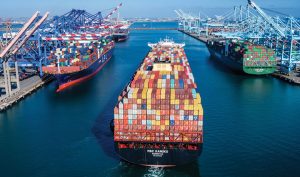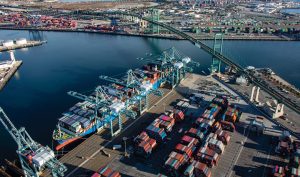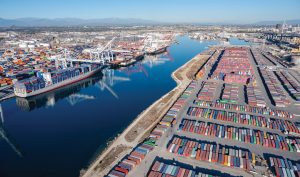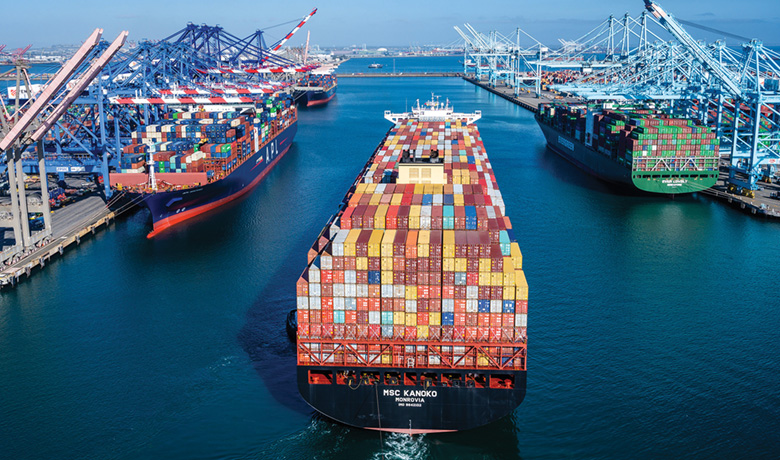Southern California ports experienced an eventful 2021. For Los Angeles and Long Beach, headlines were dominated by record cargo volumes and COVID-driven congestion that saw ships stuck at anchor and containers stacked high at marine terminals. For the Port of San Diego, it was seeing an overflow of cargo that doesn’t normally come across local docks.
And while the pandemic continues to be a challenge, it has also prompted the three ports to evolve and adapt, whether by advancing cargo visibility technology, expediting efforts toward a 24/7 operations system or making infrastructure upgrades for future demand.
The ports also hope to benefit from the Biden Administration’s and California Gov. Gavin Newsom’s recent commitment to invest in ports: the Infrastructure Investment and Jobs Act, which includes $17 billion for ports and inland waterways, and Newsom’s $2.3-billion proposal aimed at tackling bottlenecks along the supply chain.
This is expected to add to the various short-term and long-term infrastructure projects being planned for and already in the works at Los Angeles, Long Beach and San Diego.
Here’s what’s been happening over the past year at the three seaports:

LOS ANGELES
The Port of Los Angeles wrapped up 2021 with a record of roughly 10.7 million 20-Foot Equivalent Units (TEUs), beating its 2018 record by 13%. The 115-year-old seaport saw 18 straight months of record cargo volume and eclipsed one million TEUs last May, another first for Los Angeles.
But with record numbers came unprecedented congestion affecting every part of the supply chain. The port worked closely with local, state and federal leaders, including those in the Biden-Harris Administration who visited the port to see the congestion issues first-hand.
Not long after, President Biden announced plans to combat the bottlenecks, and White House Port Envoy John Porcari began meeting with the port three times a week to find operational issues and come up with short-term solutions.
Billions of dollars in federal and state funding for ports also have been announced.
“This level of funding commitment represents a monumental opportunity for ports,” Port Executive Director Gene Seroka said at a Jan. 20 State of the Port address. “Beyond freight system improvements, it funds much-needed digital and cyber security infrastructure. It supports our creation of a future-ready goods movement workforce. And it aligns with our mission to lead the nation in the development of zero-emissions port drayage.”

The cargo surge prompted the port last year to accelerate its $2.6 billion capital plan, Seroka said.
“As a landlord port with finite space, this surge of imports has especially underscored our need to be able to flex and scale the use of our properties,” he said. “In times like this, that means having more swing space to ease terminal congestion.”
The port, with the Biden Administration’s support, started “Accelerate Cargo L.A.,” a pilot program with some major cargo owners and freight service providers to move toward a “push” system that would allow their containers to move out more quickly from terminals and into the market.
The port, along with neighboring Long Beach, announced in October the adoption of an Excess Dwell Fee for containers lingering at docks past their allotted time.
“Merely announcing the fee reduced the number of those idling containers by more than 50%,” Seroka said. “The results have been phenomenal and I’m happy to say we have not implemented the fee.”
The port is also considering a similar fee for empty export containers at its terminals, as well as an incentive that would reward ocean carriers to re-position empties to help U.S. exporters.
“We call on the ocean carriers to be responsive and evacuate those boxes from our facilities so that we never have to collect a dime,” Seroka said.
After being sidelined by the pandemic for the last 18 months, cruising returned to Los Angeles last September with over 200 sailings planned for this year, the most since 2008, Seroka said.
“That’s great news for our economy, because every ship call generates roughly $1 million in local payroll and business activity,” he said. “While no other segment of the travel industry has guest health requirements and operational protocols as stringent as the cruise sector, they continue to face the headwinds of this pandemic.”
A major part of improving cargo flow for the port has been embracing technology, and the port’s efforts to digitize the supply chain continue with the launch of software tools to help give stakeholders more cargo visibility.
Last year, the port expanded the Port Optimizer system it developed with equipment and systems provider Wabtec by launching of Control Tower, which gives stakeholders exact shipping information and real-time data on operational conditions. This allows for better shipment management and opens up space at terminals, Seroka said.
“It’s a cutting-edge tool that helps major shippers prioritize seasonal cargo ahead of less time-sensitive goods,” he said.
Environmental initiatives continue to be a priority for the port, which is in the process of demonstrating a total of 107 zero-emission and 27 near-zero emission cargo handling, drayage and other vehicles and equipment. The port hopes to surpass 200 units over the next 18 months, Seroka said.
The port also plans to break ground on a goods-movement training campus, thanks to Newsom’s $110 million commitment over the next three years. That’s in addition to charging ahead on a series of infrastructure projects.
Currently in the final design stages is a project to build about 382 linear feet of concrete wharf with seismic upgrades. The port hopes to begin construction by the end of 2022.
Meanwhile, construction is expected to begin in July on a new $44.8-million marine oil platform at the Shell Oil Terminal, a project that comes with a new 30-year lease. The work, which is slated for completion in 2024, involves demolishing the timber wharves, building and running a new wharf at Berth 168 and making improvements to link the new loading platform to landside pipelines and utilities, according to the port.
Los Angeles is also finalizing the design of another marine oil platform, a $25.7-million project, at the PBF Energy Oil Terminal. Work on the new terminal at Berth 238 encompasses a new 125-foot by 58-foot unloading platform, berthing and mooring dolphins, catwalks and access ramp and demolishing a pair of unloading platforms at Berths 238 and 239. Construction on the proposed project, which would come with a new 30-year lease, could start as early as July 2023.
The port is also focused on a few rail-related projects to cut service delays, improve efficiency and meet future demand.
One project involves closing a short gap in track between the West Basin area of the port and the Alameda Corridor by adding a second mainline track.
The $17.29 million project, which started in April, involves building about 5,000 track feet of rail alongside the San Pedro Main track between John S. Gibson Boulevard and the south side of McDonald Avenue, and changes to the West Basin ICTF lead track and relocating utilities. The port expects that work to be done this year.
Meanwhile, a $40.5 million project to expand the railyard at Berths 302-305 with five more tracks is in design, which if completed, would give the port 10% more on-dock rail overall.
The port is also looking at a $49.8 million project to expand the Pier 400 rail storage yard and hopes to start construction this year. The project, which would include a concrete rail bridge, six new railroad storage tracks and other work, would help the port meet future rail demand on Terminal Island.

PORT OF LONG BEACH
Like neighboring Los Angeles, the Port of Long Beach has seen massive cargo growth spurred by the COVID-19 pandemic and evolving consumerism.
“Money consumers previously spent on services shifted to the purchase of goods, particularly online,” said Port Executive Director Mario Cordero.
That has led to two straight years of record cargo highs in Long Beach: 8.1 million TEUs in 2020, rising to nearly 9.4 million TEUs in 2021, up 15.7% over the previous year.
“The ongoing collaboration with our labor force and industry partners lifted us to this extraordinary record during a challenging time,” Steven Neal, president of the Long Beach Board of Harbor Commissioners, said. “We anticipate further collaboration in 2022 as we work toward developing immediate and long-term solutions that will alleviate congestion at our port complex.”
The record cargo and the massive backlog it has created have opened the discussion for moving toward 24/7 operations in Long Beach, a need that Cordero has been talking about since his 2018 “State of the Port” address.
“We live in a world where a consumer can buy a product any time, whether it’s 4 p.m. or 4 a.m.,” Cordero said. “Our partner ports in Asia are already operating around the clock. It makes sense for us as a part of the global supply chain to work the same way.”
To address those challenges and leverage those opportunities, the port has instituted a series of measures to smooth the flow of cargo during the COVID-19 pandemic. More than a year ago, a short-term overflow resource yard opened on Pier S. In September, the port started a Truck Alert notification testing system and the 24/7 pilot program with Total Terminals International at Pier T.
And in October, Cordero met with President Biden at the White House and received Biden’s support for 24-hour operations to address the shipping crisis.
“It’s not going to be easy, and we need warehouses and truckers to match our hours for it to work,” Cordero said. “But cargo growth is here to stay, and I’m confident the supply chain is going to do what it takes.”
Meanwhile, the Port of Long Beach is moving ahead on various projects, including the Pier B On-Dock Rail Facility, the key component in the port’s rail infrastructure program. Once completed, the facility is expected to bolster the port’s rail capacity, make cargo movement more efficient and reduce air pollution with fewer truck trips.
By the middle of the decade, the facility would double the capacity of the existing Pier B rail yard, according to Cordero. Construction is expected to start in 2023, with the initial arrival, departure and storage tracks anticipated to be done in 2025. More tracks are expected to be in service in 2030 before the 2032 completion of the project, according to the port.
The POLB also recently finished a pair of major projects that Cordero said “are important not only to our port, but for West Coast cargo movement.”
The Long Beach International Gateway Bridge—the long-awaited cable-stay span that replaced the former Gerald Desmond Bridge—opened in late 2020 and has already seen improved trucker access to terminals throughout the port complex and eliminated traffic tie-ups. And in late 2021, the new Long Beach Container Terminal, a modern, green terminal built with advanced technology and zero-emissions in mind, was completed.
Also, SSA Marine is the first marine terminal at the port to transition its fleet of cargo-handling equipment from fossil fuel to renewable diesel fuel. The move is expected to reduce greenhouse gas emissions by 68% across its three Long Beach terminals and involves over 230 pieces of equipment.
It’s part of SSA’s bigger plan to move its cargo-handling equipment (CHE) to zero emissions by 2030. The company recently completed demonstrations on a pair of battery-electric top handlers and is transitioning nine rubber-tired gantry cranes to full electric power at Pier J. Six are already operational, while the remainder would be retrofitted. There are also plans at Pier C to deploy 33 zero-emission yard tractors, with infrastructure to support them.
There’s more to look forward to with the announcement of federal and state commitments to invest in the ports system and solutions to dealing with the cargo congestion.
“This is a global supply chain issue,” Cordero said. “Labor, trucking and trains within San Pedro Bay are ready to move these containers, but a system of destination warehouses, factories and stores that have been upended by a pandemic entering its third year create a ripple effect of closures. That said, the COVID-19 pandemic has shown how important the state’s ports and supply chain are, and we’re pleased it’s leading to more investment in infrastructure.”
PORT OF SAN DIEGO
Being in proximity to the nation’s two busiest seaports has offered the Port of San Diego—a medium-sized port about 111 miles south of San Pedro Bay – advantages in the face of ongoing bottlenecks driven by record cargo demand.
“The congestion to our north has presented opportunities for the Port of San Diego, and we are capitalizing on those opportunities as much as we can,” said Michael LaFleur, vice president of maritime for the port.
The port said it has been fielding an average of 30 requests a month since March 2021 from companies and carriers with whom San Diego doesn’t typically do business.
“Based on our size, capacity, infrastructure and available labor, we have been able to take in about two to four cargo vessels a month with various types of cargo,” LaFleur explained.
That includes some container cargo, lithium batteries for solar and wind farms, juice concentrate for use in juice tetra-packs for children and various home improvement goods for nationally recognized firms. That has resulted in an additional 250 to 500 FEUs (40-Foot Equivalent Units) on average per month since March 2021.
“We are confident some of these short-term opportunities will develop into longer-term relationships,” LaFleur said.
That said, San Diego, a port that specializes in bulk and breakbulk cargo, is being careful not to allow this surge in demand to overtake its loyal customer base or its commitment as one of the nation’s 17 commercial strategic ports. In that capacity, San Diego’s National City and Tenth Avenue Marine Terminals must always be available to support military deployment activities within a 48-hour notice. In January, for instance, San Diego declined additional volume because of a military move.
“It’s important to note that we are prioritizing our commitments to and agreements with our existing cargo businesses and customers, ensuring that any spot cargo we do take in does not interfere with or slow down their operations,” LaFleur said.
Speaking of existing businesses, Pasha Automotive Services, which operates out of National City Marine Terminal, remained relatively stable despite the COVID-19 pandemic and supply chain disruptions, processing 361,008 imported autos for fiscal year 2021, according to the port.
Meanwhile, San Diego has been planning for the future. In January, port commissioners awarded a $268,000 contract to Baker Electric Inc. to install electrical equipment and other work that will go toward doubling San Diego’s shore power capability at the port’s B Street and Broadway Pier cruise ship terminals. The project also will significantly lower air emissions.
The work is set to start in March and be ready for commissioning by August. It is part of the $4.6 million shore power project that would allow two cruise ships to connect to shore power at the same time.
The port also finished its $24-million Tenth Avenue Marine Terminal modernization project last fall. The upgraded terminal means more laydown space and flexibility for project cargo such as windmill components, roll-on/roll-off and break-bulk cargo.
In addition to the TAMT redevelopment and doubling shore power at cruise terminals, the port plans to be the first in the U.S. to be served by a fully electric tugboat. The eTug, being built by Crowley, is set to be deployed in mid-2023. When in operation, the eTug is expected to curb 178 tons of nitrogen oxide, 2.5 tons of diesel particulate matter and 3,100 metric tons of carbon dioxide within its first decade in service. It also would replace a conventional tug that consumes over 30,000 gallons of diesel annually.
Also, a Foreign Trade Zone activation approved in 2020 by U.S. Customs and Border Protection and the City of San Diego at Tenth Avenue Marine Terminal is up and running, with the designation offering some logistical benefits, such as faster shipments and duty savings.

